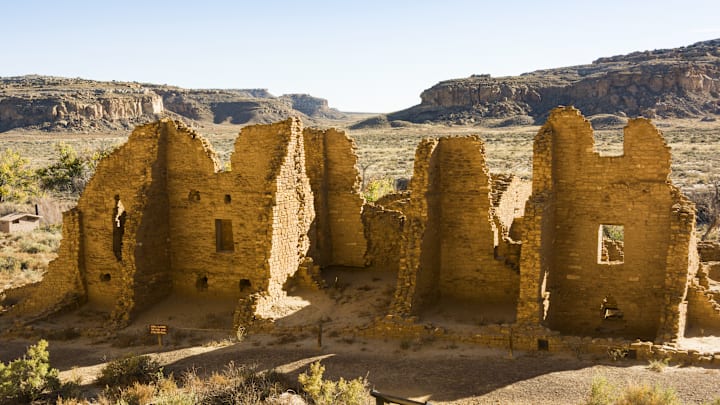Chaco Canyon National Historical Park is nestled deep in the Navajo Nation of modern-day New Mexico. Surrounded by desert and only accessible by unpaved roads, it usually receives fewer than 5000 visitors a month. But within this remote location, the ruins of a vanished civilization rise from the desert grasses. It was once the vibrant religious center of a Native American culture—one whose collapse long remained a mystery.
Chaco Canyon: The Center of the Universe
The Ancestral Puebloans (previously known as the Anasazi, a term now recognized as derogatory) flourished in America’s Four Corners region before the arrival of Columbus. Archaeologists believe the decision to build in a desert was religious; many of the buildings follow an astrological alignment that would have required generations of celestial study. Chaco Canyon seems to have been at the center of this cosmology, an important intersection for many people. But the inhospitable environment meant food and supplies needed to be imported.

A complex system of roads linked hundreds of Ancestral Puebloan communities, which was crucial when construction at Chaco Canyon began around 850 CE. The 150 buildings were made of huge sandstone blocks and wooden beams. They followed meticulous plans and, like European cathedrals, some took generations to complete. The largest is Pueblo Bonito, which covers almost three acres, has over 600 rooms and, at time of completion, was four or five stories high. Pueblo Bonito also contained 32 circular subterranean meeting rooms known as kivas. Fifteen extra-large kivas (called “great kivas”) were built across the city, each capable of holding 400 people.
And then, only about 300 years later, the Ancestral Puebloan civilization collapsed.
Chaco Canyon fell slowly. After 1150, new construction stopped. Doorways were sealed with stone as the occupants left. Ceremonial kivas were dismantled and burned. Archeologists discovered evidence of warfare in other Ancestral Puebloan settlements; one contained feces that tested positive for cannibalism. New settlements, when they appeared, were constructed into easily defendable cliffsides. But what could have caused such a dramatic change?
Amberat Has Answers
Enter the pack rats. As the name suggests, these rodents are the original hoarders. They have bigger ears, furrier tails, and a greater love of shiny objects than others of their kind. Much of their time is spent collecting nearby items and bringing them home to eat, build with, or simply admire.
Like any good home, the pack rat nest has a bathroom-slash-trash area. In most places, these “middens” are gross and uninteresting—but in dry environments, the rat urine slowly crystallizes into an asphalt-like crust called “amberat” that acts as a shocking effective preservative. And, like with humans, the best pack rat nests get passed down through generations. As each rat family redecorates the family nest, new material is encased in the urine-based amberat; some pack rat nests have material dating back to 50,000 years ago. For scientists and archeologists, these nests are a treasure trove of data.
Since 1960, more than 2000 North American pack rat nests have been collected and analyzed. Pollen analysis at Chaco Canyon showed that the environment for the Ancestral Puebloans was the same as it is today—with one notable difference: pinyon pines. During the construction boom, all the canyon’s pinyon pine was logged for construction and firewood, disappearing from pack rat nests around 980 CE. As a result, trees were imported from the Chuska and San Mateo Mountains. Over 200,000 logs were hauled 50 to 60 miles to build Chaco Canyon’s massive structures.

Deforestation was just the beginning. As the Ancestral Puebloan population climbed, there was greater demand for corn. However, trees play a crucial role in holding nutrient-rich soil in place. When drought hit in 1130, it was obvious the people of Chaco Canyon had been living too close to the edge. Corn made up the bulk of their diet, as well the diet of their main source of meat: domesticated turkeys. Without it, Chaco Canyon couldn’t survive. Other factors, like social stratification or religious differences may have played a role in the city’s decline, with simmering resentments finally bubbling over in the drought.
The Ancestral Puebloans may have been the first people in North America to realize the consequences of altering the environment, but they were certainly not the last. In the 1930s, farmers learned that disturbing prairie grasses and natural topsoil leads to dust storms. Today, excess carbon dioxide from fossil fuels has altered global weather patterns, and the consequences have already begun. And as the world continues to change, pack rats will keep hoarding, preserving data for the future.
Discover More Stories About History:
